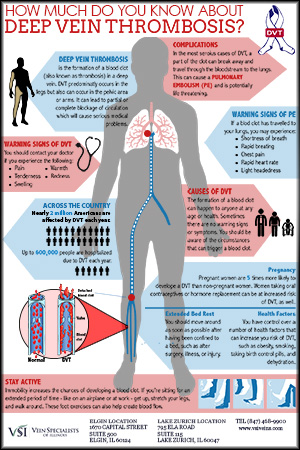Contact us today.
Deep Vein Thrombosis
Deep Vein Thrombosis Can Be a Complication of Varicose Vein Disease
A blood clot inside a vein deep in the body is called deep vein thrombosis, or DVT, and can be a complication of varicose veins when it forms in the leg. DVT may not have any symptoms but can cause pain, swelling and warmth in the leg.

In our continuing efforts to help build awareness for this potentially life threatening medical complication we have created this Deep Vein Thrombosis Infographic overview. Download the PDF here.
If untreated, people with Deep Vein Thrombosis are at risk for developing a pulmonary embolism in which the blood clot breaks away and travels to the lung. A pulmonary embolism is a serious, even life threatening condition.
Approximately 60,000 people in the United States die from a pulmonary embolism each year. As we age, the risk for a pulmonary embolism doubles for each 10 years after the age of 60.
Reduce Your Risk of DVT
Vacations are a particularly dangerous time for DVT. Travel on an airplane, car, bus or train increases your risk, especially if you have recently had surgery, are pregnant, are overweight or have a history of blood clots.
Risk of DVT should not keep you from traveling if you take these simple steps.
- Wearing compression stockings while traveling can significantly reduce your risk for DVT. These stockings help increase the circulation in your legs. Make sure to purchase medical grade stockings.
- Stay hydrated. Drink lots of water and avoid caffeine or alcohol because both are dehydrating.
- Wear loose, comfortable clothes during the trip.
- Get up out of your seat every hour or two. In an airplane, it is helpful to request an aisle seat so it is easier to stretch out and move around. In a car, stop at a gas station or rest area and walk around every couple of hours.
- While seated, rotate your ankles, draw circles on the ground with your toes, flex your feet and toes and raise your legs slightly and holding them in the air for a few seconds.
Diagnosis and Treatment
The veins of the legs are classified anatomically. The “deep” veins are within and below the muscles and the “superficial” veins are above the muscles. DVT (Deep Vein Thrombosis) is where a thrombus or clot obstructs a vein. It is a serious condition that can lead to disability and even death if the thrombus travels through the bloodstream to the lungs. When this happens, it is called a Pulmonary Embolus (PE). Although most DVT resolves with appropriate management, massive pulmonary embolism causes as many as 300,000 deaths annually in the United States (footnote source: Tapson VF, Acute Pulmonary Embolism. New England Journal of Medicine 2008 Mar 6. 358(10):1037-52.)
- Signs may include: edema (swelling), pain and warmth of the affected leg. Complication of DVT include: pulmonary embolus (PE), recurrent DVT and post-thrombotic syndrome (chronic pain, swelling, skin changes or even ulceration of the affected leg).
- Diagnosis of DVT: lower extremity ultrasound exam
- Diagnosis of Pulmonary Embolus: CT Scan, Ventilation Perfusion Scan
Treatment:
- Anticoagulation with oral or injectable medication (“blood thinners”). This is the most common treatment.
- Pharmacologic thrombolysis (infusion of drugs directly into the thrombus through a catheter that dissolve the clot)
- Surgical or minimally invasive interventions to physically remove the clot
- Compression stockings (used for small, below the knee thrombus)
- Ambulation
- IVC Filter (a small mesh filter surgically placed into the vein to prevent the clot from traveling to the lungs) if patient cannot be on blood thinners
Contact Us for Your Free Vein Screening
For more information, you may contact Vein Specialists of Illinois at 847-468-9900, located in Elgin and Lake Zurich. You may also use this form to schedule your Free Vein Screening!

